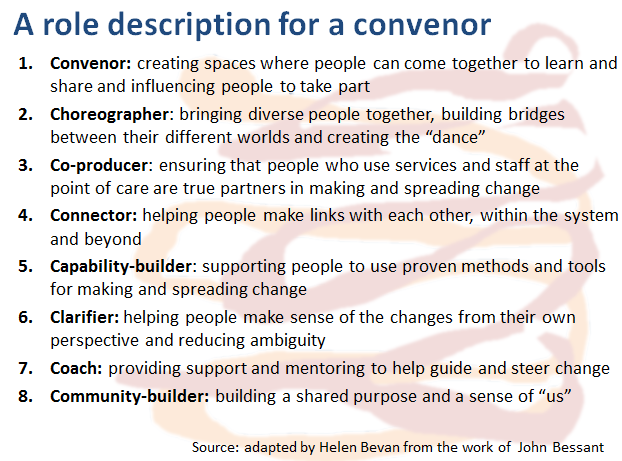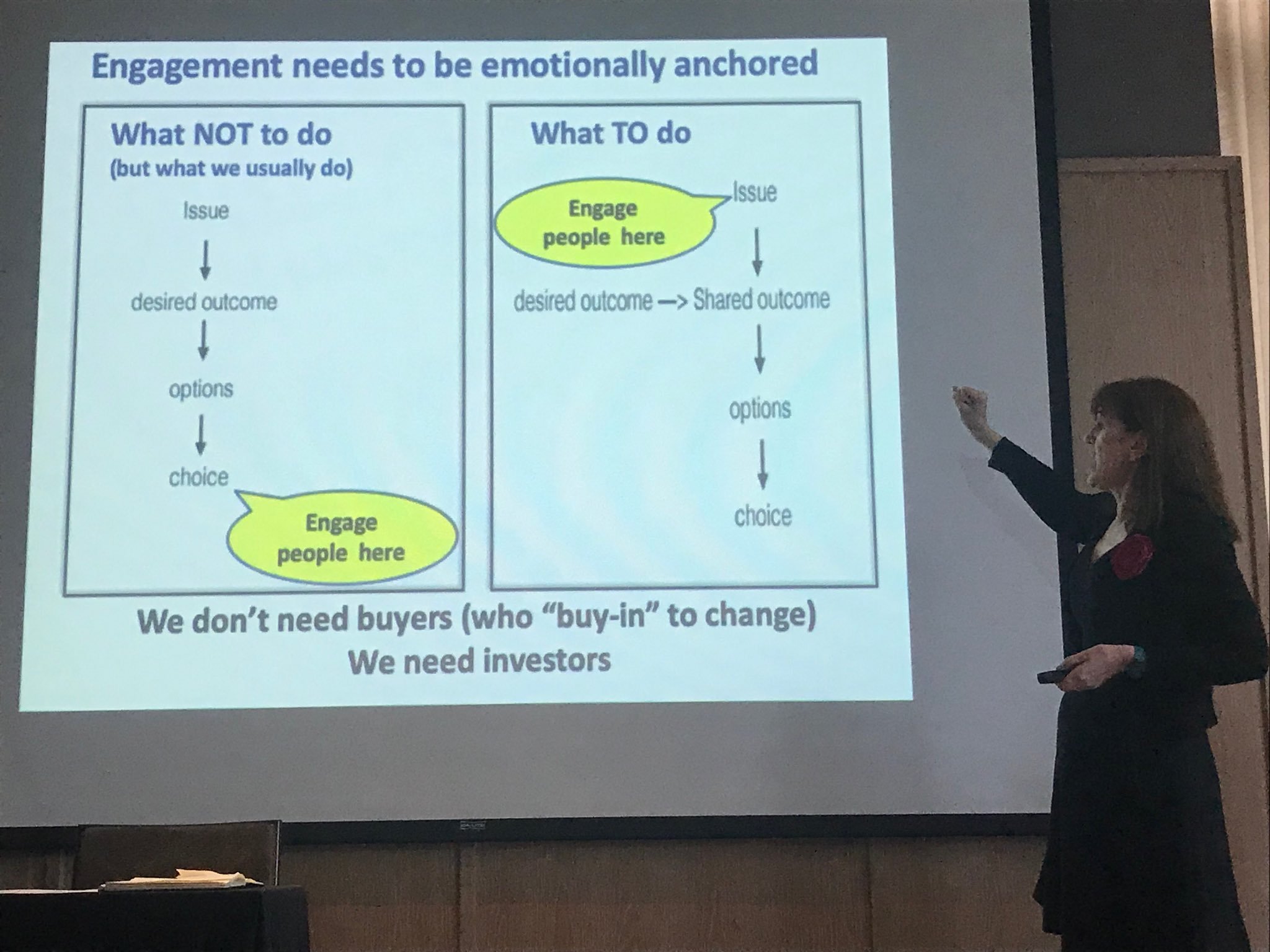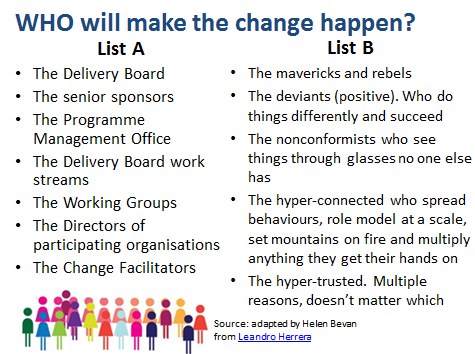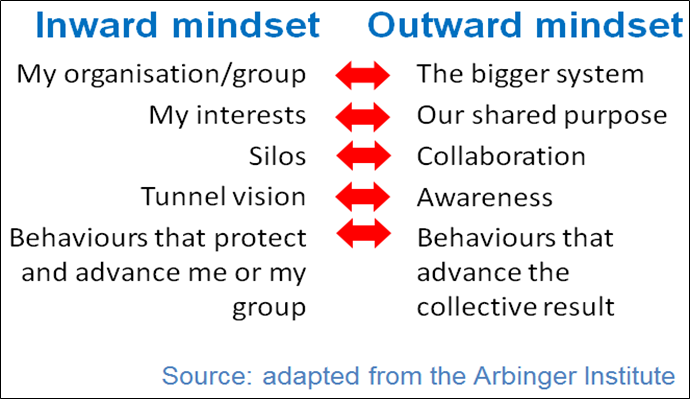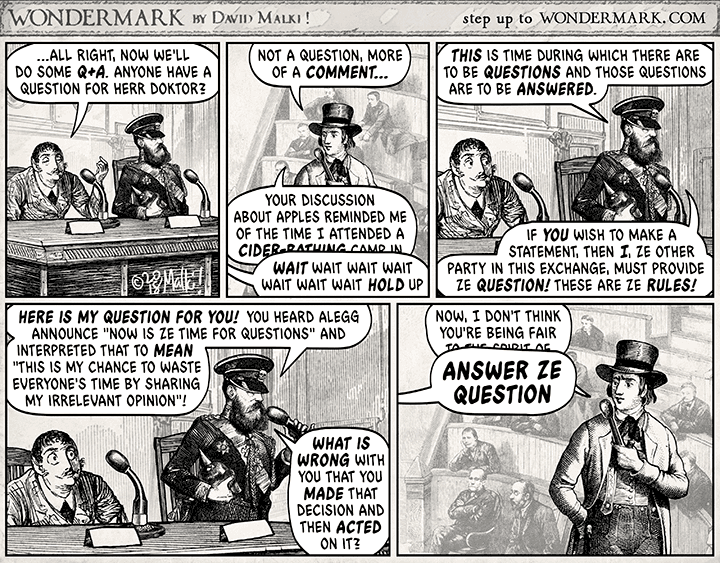Archive for the ‘English’ Category
Change: When to Engage?
Wednesday, September 18th, 2019@ACHSaccred CEO day Asia Pacific Forum with @helenbevan How to better engage staff involve them at the level of the issues not when you have decided on your solution. Use methods of relational social networks rather than broadcast methods pic.twitter.com/lNfeUgEjQO
— Bernie Harrison (@bernieharry) September 18, 2019
Birmingham Life Expectancy
Wednesday, September 11th, 2019WHO will make the change happen?
Tuesday, September 10th, 2019Helen Bevan (@helenbevan) excels at producing evidence on the best ways to "rock the boat" (and the boat she has to instill change into is a huge rusted vessel). Here are two recent illustrations, along with her comments.
Often in big change initiatives, we focus on the people with power in the formal system. Yet the people who can make or break the change are typically a completely different set of people. We need to work with both. Thanks @LeandroEHerrero for the inspiration.
I would like to shift the balance in leadership thinking from inward to outward mindset (& have a system that rewards an outward mindset).
Q & A
Monday, June 24th, 2019I was just asked by a colleague how I facilitate Q & A sessions—I guess the word is out that I am very deliberate about how an academic Q & A should go after a talk or panel. I think of this as an Indigenous feminist approach to facilitating academic Q & A. 1/
— Eve Tuck (@tuckeve) June 20, 2019
I was just asked by a colleague how I facilitate Q & A sessions—I guess the word is out that I am very deliberate about how an academic Q & A should go after a talk or panel. I think of this as an Indigenous feminist approach to facilitating academic Q & A.
Ever since I was in graduate school, I thought I hated giving public talks. But I soon realized it’s not the presentation, but the Q & A that can feel so awful. Academic audiences can be arrogant, hostile, and self-absorbed.
People don’t always bring their best selves to the Q & A—people can act out their own discomfort about the approach or the topic of the talk. We need to do better. I believe in heavily mediated Q & A sessions.
Before I give a talk, I ask my host to please find someone to facilitate the Q & A. It is better for someone who knows the people in the audience to choose who gets to ask questions in public, because they know who is a bully, who to avoid, who will derail a conversation.
The tips in this thread are both what I do after my own talks, and what I do when I am chairing a session. I especially do this for graduate students and early career scholars.
I make it clear that it is the audience’s responsibility to help craft a positive public speaking experience for graduate students and early career scholars. I tell the audience to help keep the good experience going and tell them not to ask violent questions.
Right after I am finished talking or all the panelists have shared their papers, I invite the audience to take 5-10 minutes to talk to each other. After 45-70 minutes of listening, people are bursting to talk, and taking the time to turn to talk to a neighbor keeps the first question from being from a person who just felt the urgency to talk. Also, I often need a breather and a moment to drink water or even step out to use the washroom.
So, I give the audience 5-10 minutes to talk to a neighbor. I suggest that they use the time to peer review their questions.
I say that this is a time for them to share a question they are considering posing in the Q & A, and that they should
a) make sure it is really a question;
b) make sure they aren’t actually trying to say that THEY should have given the paper;
c) figure out if the question needs to be posed and answered in front of everyone;
d) I remind the audience that the speaker has just done a lot of work, so they should figure out if their question is asking the speaker to do work that really the question-asker should do.
Then, after 5-10 mins, I will sometimes ask for the first question to come from particular people in the room— Indigenous graduate students, etc.
Or, if opening it up for anyone to begin, I will ask, "did you peer review your question?" before the person takes the mic.
People kind of laugh it off, but once they realize that I am serious–that the expectation is that they are thoughtful about the quality of their question and whether it really needs to be asked–it often helps to make the conversation much more satisfying.
We often treat Q & A as something that is to be endured, and are willing to gamble on it not going well by having very passive facilitation. We can shift how we interact with one another and make it better. Thanks to Daniel Heath Justice @justicedanielh for asking about this!
Wikipedia extends your mind
Saturday, March 30th, 2019Yet another great XKCD.
The sound of a vinyl record player amid rubble and dust in Aleppo
Friday, March 1st, 2019Personal Knowledge Mastery
Tuesday, February 19th, 2019PKM by Harold Jarche (@hjarche). More at https://jarche.com/.
Anonymous for fifteen minutes
Friday, December 28th, 2018Woolsey Fire
Saturday, November 10th, 2018This amazing picture is a pretty good demonstration that the end of the world can look great. Keep on living like there is no climate issue, brave American people, there is more beauty of this kind ahead.
From a tweet by LA County Sheriff’s (@LASDHQ)
Photo by Grant Denham (@GrantDenham)
The Creative Process Crossroads
Friday, October 26th, 2018Comic by Wiley Miller (@TheWileyMiller).
Early Detection of Breast Cancer by Mammography Screening
Sunday, September 30th, 2018America
Friday, September 28th, 2018Things that happen in Silicon Valley and also the Soviet Union
Tuesday, July 10th, 2018Great Twitter thread by Anton Troynikov (@atroyn)
Things that happen in Silicon Valley and also the Soviet Union:
- waiting years to receive a car you ordered, to find that it's of poor workmanship and quality
- promises of colonizing the solar system while you toil in drudgery day in, day out
— Anton Troynikov (@atroyn) July 5, 2018
Things that happen in Silicon Valley and also the Soviet Union:
- waiting years to receive a car you ordered, to find that it’s of poor workmanship and quality
- promises of colonizing the solar system while you toil in drudgery day in, day out
- living five adults to a two room apartment
- being told you are constructing utopia while the system crumbles around you
- ‘totally not illegal taxi’ taxis by private citizens moonlighting to make ends meet
- everything slaved to the needs of the military-industrial complex
- mandatory workplace political education
- productivity largely falsified to satisfy appearance of sponsoring elites
- deviation from mainstream narrative carries heavy social and political consequences
- networked computers exist but they’re really bad
- Henry Kissinger visits sometimes for some reason
- elite power struggles result in massive collateral damage, sometimes purges
- failures are bizarrely upheld as triumphs
- otherwise extremely intelligent people just turning the crank because it’s the only way to get ahead
- the plight of the working class is discussed mainly by people who do no work
- the United States as a whole is depicted as evil by default
- the currency most people are talking about is fake and worthless
- the economy is centrally planned, using opaque algorithms not fully understood by their users
Welcome to America
Thursday, June 21st, 2018To Try List
Monday, May 21st, 2018Planet or Plastic?
Thursday, May 17th, 2018Entrepreneurship is not a job
Tuesday, April 24th, 2018A true must read by Seth Godin @ThisIsSethsBlog
Entrepreneurship is not a job
You don’t apply. You don’t get a salary. No one picks you.
Bragging about how much money you’ve raised or what your valuation is a form of job thinking.
Entrepreneurship is a chance to trade a solution to someone who has a problem that needs solving.
Solve more problems, solve bigger problems, solve problems more widely and you’re an entrepreneur.
It’s tempting to industrialize this work, to make it something with rules and bosses and processes. But that’s not the heart of it.
The work is to solve problems in a way that you’re proud of.
Stormy
Thursday, April 12th, 2018General Characteristics of Complex Systems
Monday, March 12th, 2018In an article from march 2000 titled What can we learn from a theory of complexity?, Paul Cilliers enumerates the general characteristics of complex systems:
- Complex systems consist of a large number of elements that in themselves can be simple.
- The elements interact dynamically by exchanging energy or information. These interactions are rich. Even if specific elements only interact with a few others, the effects of these interactions are propagated throughout the system. The interactions are nonlinear.
- There are many direct and indirect feedback loops.
- Complex systems are open systems—they exchange energy or information with their environment—and operate at conditions far from equilibrium.
- Complex systems have memory, not located at a specific place, but distributed throughout the system. Any complex system thus has a history, and the history is of cardinal importance to the behavior of the system.
- The behavior of the system is determined by the nature of the interactions, not by what is contained within the components. Since the interactions are rich, dynamic, fed back, and, above all, nonlinear, the behavior of the system as a whole cannot be predicted from an inspection of its components. The notion of "emergence" is used to describe this aspect. The presence of emergent properties does not provide an argument against causality, only against deterministic forms of prediction.
- Complex systems are adaptive. They can (re)organize their internal structure without the intervention of an external agent.
Then he applies these characteristics to social organizations after stating that Complexity theory has important implications for the general framework we use to understand complex organizations, but within that (new) framework we must still be clear, as well as decisive.
- Since the nature of a complex organization is determined by the interaction between its members, relationships are fundamental. This does not mean that everybody must be nice to each other; on the contrary. For example, for self-organization to take place, some form of competition is a requirement (Cilliers, 1998: 94-5). The point is merely that things happen during interaction, not in isolation.
- Complex organizations are open systems. This means that a great deal of energy and information flows through them, and that a stable state is not desirable. More importantly, it means that the boundaries of the organization are not clearly defined. Statements of "mission" and "vision" are often attempts to define the borders, and may work to the detriment of the organization if taken too literally. A vital organization interacts with the environment and other organizations. This may (or may not) lead to big changes in the way the organization understands itself. In short, no organization can be understood independently of its context.
- Along with the context, the history of an organization co-determines its nature. Two similar-looking organizations with different histories are not the same. Such histories do not consist of the recounting of a number of specific, significant events. The history of an organization is contained in all the individual little interactions that take place all the time, distributed throughout the system.
- Unpredictable and novel characteristics may emerge from an organization. These may or may not be desirable, but they are not by definition an indication of malfunctioning. For example, a totally unexpected loss of interest in a well-established product may emerge. Management may not understand what caused it, but it should not be surprising that such things are possible. Novel features can, on the other hand, be extremely beneficial. They should not be suppressed because they were not anticipated.
- Because of the nonlinearity of the interactions, small causes can have large effects. The reverse is, of course, also true. The point is that the magnitude of the outcome is not only determined by the size of the cause, but also by the context and by the history of the system. This is another way of saying that we should be prepared for the unexpected. It also implies that we have to be very careful. Something we may think to be insignificant (a casual remark, a joke, a tone of voice) may change everything. Conversely, the grand five-year plan, the result of huge effort, may retrospectively turn out to be meaningless. This is not an argument against proper planning; we have to plan. The point is just that we cannot predict the outcome of a certain cause with absolute clarity.
- We know that organizations can self-organize, but it appears that complex systems also organize themselves toward a critical state. This not only means that at any given point we can expect the system to respond to external events on all possible scales of magnitude, but also that the system will organize itself to be maximally sensitive to events that are critical to the system’s survival. Think of language as a complex system. If there is a desperate need for new terms to describe important events, the system will organize itself to be critically sensitive to those terms specifically, and not necessarily to other novel terms. The "need" is determined by the context and the history of the system, not by a specific "decision" by some component of the system. Similarly, an organization will self-organize to be critically sensitive to specific issues in the environment that may affect its wellbeing. The implications of self-organized criticality for organizational systems seems to be a subject that demands further investigation.
- Complex organizations cannot thrive when there is too much central control. This certainly does not imply that there should be no control, but rather that control should be distributed throughout the system. One should not go overboard with the notions of self-organization and distributed control. This can be an excuse not to accept the responsibility for decisions when firm decisions are demanded by the context. A good example here is the fact that managers are often keen to "distribute" the responsibility when there are unpopular decisions to be made—like retrenchments—but keen to centralize decisions when they are popular.
- Complex organizations work best with shallow structures. This does not mean that they should have no structure. This point requires a little elaboration. Complexity and chaos—whether in the technical or the colloquial sense—have little to do with each other. A complex system is not chaotic, it has a rich structure. One would certainly not describe the brain or language, prime examples of complex systems, as "chaotic." I certainly would not put my trust in a chaotic organization. A complex system does have structure, but not a strictly hierarchical structure; perhaps not even a shallow structure. Structure can be shallow, but still extremely hierarchical. Perhaps the best way to think of this would be to say that there should be structure on all scales, and much interaction between different structural components. This is another aspect of complex organizations that could be fleshed out with insights from self-organized criticality.

